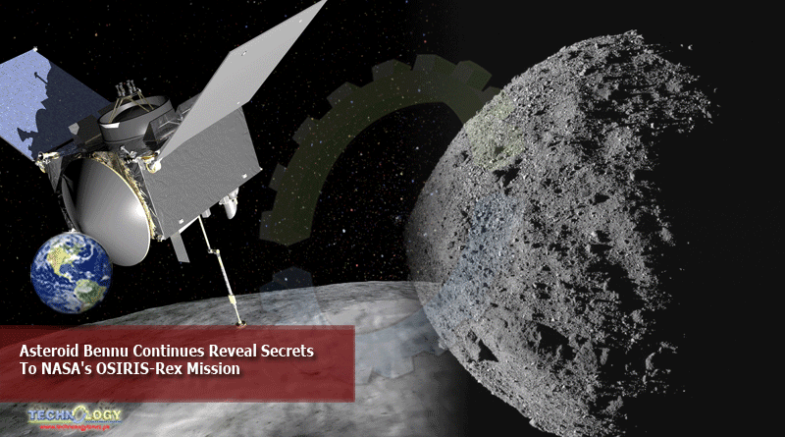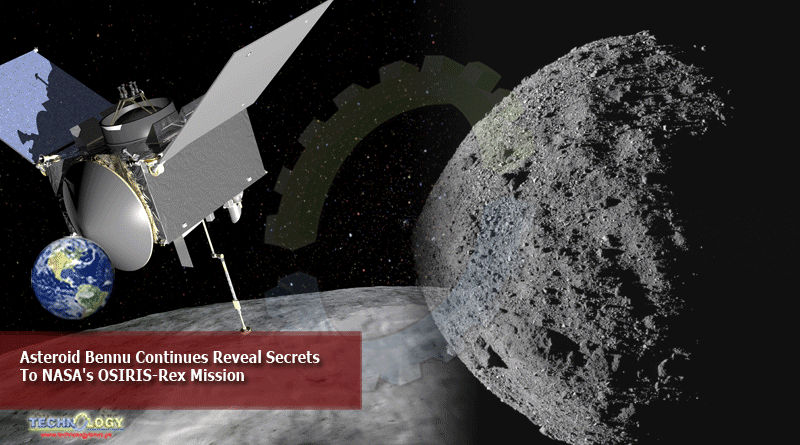Near-Earth Asteroid Bennu Continues To Reveal Its Secrets To NASA’s OSIRIS-REx Mission, Which Is Orbiting Space Rock For Nearly 2 Years.

New research reveals veins of carbonite materials in Bennu’s boulders, as well as signs of organic minerals widespread across its surface. The variety of rock compositions on the asteroid’s surface, the gravity of the asteroid, and the unbalanced, diamond-shaped structure of the asteroid’s body suggest that Bennu formed after the collision of two parent asteroids, the study found.
Altogether, the new results provide a baseline for the samples that OSIRIS-REX will collect from Bennu’s surface on Oct. 20. The spacecraft is expected to bring those samples back to Earth in 2023, if all goes according to plan, and will reveal not only insight about the asteroids that pass near our planet but also a glimpse of the first ten millions years after the sun’s formation.
In the process of building planets, the early solar system also created a lot of little debris that would never become a world. These leftovers have many of the same signatures of planetary building blocks but just didn’t quite make it into the finished product. Many of these drifted to the asteroid belt, though some were hurled back towards Earth early on to deposit water on the surface of the then-dry planet.
“Because it migrated from the main asteroid belt into an Earth-crossing orbit, Bennu is a prime example of how material could have been delivered to the early Earth from farther out in the solar system,” Amy Simon, a researcher at NASA’s Goddard Flight Center in Maryland, told Space.com in an email. Simon is the author of one of six papers on Bennu published today (Oct. 8) in the journals Science and Science Advances.
“The widespread evidence of both carbonates/organics and hydrated minerals on Bennu bolsters the argument that asteroids and comets may have brought the needed building blocks for life here to Earth and other planets,” she said.
Bennu’s boulders
Over the last two years, OSIRIS-REx has collected enough images of Bennu to map the asteroid’s surface. Variations in the color and albedo (brightness) provide insights into the asteroid’s “skin,” as well as revealing how it changes over time.
Bennu is considered a rubble pile asteroid, gravitationally coalescing after something slammed into its original parent body. By comparing the differences in color and albedo in the boulders and craters, scientists were able to determine that the asteroid is made up of two distinct populations of boulders.
According to Daniella DellaGiustina, a planetary scientist at the University of Arizona, the leading hypothesis for the appearance of these separate populations is that the original asteroid contained several separate zones that underwent distinct geological processes. When Bennu drew together after the impact that shattered that object, it gathered material from at least two of those zones, DellaGiustina told Space.com.
OSIRIS-REx has also spotted several small boulders with compositions similar in many ways to the asteroid Vesta, the second largest object in the asteroid belt. Those boulders may provide insights into the object that shattered Bennu’s parent body. “We think these rocks originated from a fragment of Vesta that collided with Bennu’s parent body and were also inherited when Bennu formed,” DellaGiustina said.
Bennu also has a surprising amount of carbon-rich materials, including carbonates and organic materials. Carbonates are inorganic minerals, while organics contain carbon in more complex forms. Mapping the wavelengths of light bouncing off of Bennu can provide hints about its composition. Previous observations had already revealed the presence of hydrated phyllosilicates, or clays, on the asteroid’s surface. Now, the new research reveals that organic and carbonate materials cover Bennu’s exterior.
According to Simon, Bennu carries a wide mix of signals that could be the result of compositional variation, weathering differences, age differences, a variety of particle sizes, or some combination of all of them.
“While a global spectrum of an asteroid may show you one dominant characteristic, it’s likely that all asteroids have variation on their surface, too,” Simon said. That may explain why complex C-type asteroids associated with Bennu have a diversity of signatures.
“The true test will be analyzing the returned Bennu samples and seeing exactly how the particles vary,” Simon said.
Another team of researchers explored the physical characteristics of Bennu’s boulders using thermal infrared data to determine their surface roughness and thermal inertia (the measure of how slowly an object’s temperature changes), both of which are used as proxies for the physical characteristics of a planetary surface.
Working with his colleagues, Ben Rozitis of The Open University in the United Kingdom found that Bennu’s boulders could be classified into two types by strength. The weakest of these boulders would be unlikely to survive a fall through a planet’s atmosphere, suggesting that any meteorites of that type that were hurled towards Earth would never survive to reach the ground. The weak boulders have a low reflectance and a hummocky texture, and a lower thermal inertia than C-type asteroids.
The stronger boulders are more reflective, with angular sides and evidence for water-rich mineral deposits in their cracks. Although these boulders also have a lower thermal conductivity than similar meteorites, their numbers come close to the measurements of CM-type asteroids taken in the laboratory.
Rozitis and his team concluded that other near-Earth objects likely contain boulders similar to the ones found on Bennu, rather than the smaller, fine-grained regolith. They also suspect that the samples of material collected by OSIRIS-REx and returned to Earth will contain pieces of the boulders that would not otherwise survive a fall through the atmosphere.
The map also revealed that Bennu’s surface is weathering in a surprising way. Exposure to the charged particles streaming from the sun and the rain of micrometeorites can have important effects on space rocks. On the moon and other asteroids, scientists have found that their impact darkens the surface, causing it to reflect sunlight in longer wavelengths. But Bennu is doing something unexpected. Instead, the asteroid is growing brighter over time, its rocks reflecting shorter wavelengths of light.
“Something about Bennu is quite different than other planetary surfaces we’ve observed,” DellaGiustina said.
In the early days of the solar system, when it was a scant few million years old, heat from radioactive elements melted water ice, allowing it to interact with and change the rock of the parent body. The rapid decay of those elements means that the alteration had to happen early before the collision that destroyed Bennu’s parent body.
That water most likely created the ribbons of minerals seen in some of Bennu’s boulders. Similar veins are seen in meteorites, according to Hannah Kaplan, also at Goddard, but they range from microns to millimeters in length and width, while Bennu’s veins are 3 to 15 centimeters wide and up to 1.5 meters long. “The veins on Bennu are therefore much larger than any meteorite example we have,” Kaplan says.
Although OSIRIS-REx hasn’t spotted any vein-bearing boulders in Nightingale, the anticipated sampling region, Kaplan says that doesn’t rule out the possibility of smaller, carbonate-rich fragments. She anticipates seeing evidence of carbonate in the material returned to Earth.
Although Bennu shares several compositional traits with CM and CI meteorites, Kaplan and her colleagues found that the dominating material in the fractures was different from known meteorites. It’s possible that looking at Bennu from far away reveals different features than those captured in individual meteorites. It’s the difference between examining a mountain or a boulder on that mountain; Bennu is looking at the mountain, while meteorites are more like individual boulders.
“From a single boulder, you can get a lot of information — the mountain is mostly granite, it’s so many years old — but you might miss the fact that there are trees nearby, too,” Kaplan says.
Young and old
Bennu’s rubble-pile formation gives it a top-like shape. As the material drew together gravitationally, it began to rotate. The resulting asteroid bulges in the middle and is thinner at the poles. Bennu also has four ridges evident in its northern hemisphere, running from north to south.
In addition to mapping the surface, OSIRIS-REx scientists were also able to create a 3-D model of Bennu down to a resolution of 20 cm (8 inches). Two of the ridges were found to extend through the equator and into the high southern latitudes, and portions of all four are present in the south. In the southern region, material covers the ridges, rendering them invisible to the naked eye.
The northern and southern regions also have different low-albedo areas. South of the equator, the wide-scale darker features occur in the transition between the sloped southern cap and the flatter equatorial region. In the northern features, fewer such regions exist, and most are associated with scattered material identified as rock slides or falls.
“The differences we identified between the northern and southern hemispheres of Asteroid Bennu suggest fundamental differences in the surface properties and subsurface structures,” the authors, led by Michael Daly, a planetary scientist at York University in Canada, wrote in their paper.
The vanishing ridges may indicate a wedging rotational failure in Bennu’s history. As the spinning material collapsed down, the material that made up the ridges remained essentially whole, refusing to crumble. Their formation would have led to topographic changes that further impeded disruption, occurring either as the asteroid reaccumulated after the initial collision or later in its lifetime. In the southern hemisphere, large boulders kept material from spreading out, while in the northern hemisphere their relative paucity allowed the material to move and expose the ridges.
Last year, researchers announced that Asteroid Bennu was blowing dust off of its surface. Led by Daniel Scheeres, of the University of Colorado, Boulder, the researchers used this blown off material, along with the spacecraft itself, to track Bennu’s gravity. By modeling how both felt the tug of gravity, the researchers were able to indirectly probe the interior of the asteroid. The dust and rocky satellites revealed that Bennu has a wide variety of material inside of it that pulls differently at orbiting objects depending where they are related to the asteroid’s surface. The regions at the equator and center are less dense than the material at its poles.
Previously, researchers suggested that the equatorial bulge could be the result of its spin, as material migrates towards the equator and settles there. Gravitational observations confirm this is the case. It also suggests that the migrating material is more porous than the surrounding material, causing a lower density even as more material settles.
The center of the asteroid is also low-density, and its formation has previously been suggested to be the result of its rapid 4.3-hour spin. By comparing the spin rate of Asteroid Bennu today with the proposed spin required to transform it from a pile of rubble into an asteroid, the researchers determined that the center, which has a lower density than anticipated, may have formed early in the life of the asteroid. The size of the bulge and underdense region, both consistent with a period of rapid rotation when Bennu lived in the main belt, contrast with the recent origin of the equatorial ridges.”The mass distribution of Bennu, based on analysis of the measured gravity field, has signatures of both currently active processes and of an ancient event,” Scheeres and his colleagues wrote.
This news was originally published at space.com
